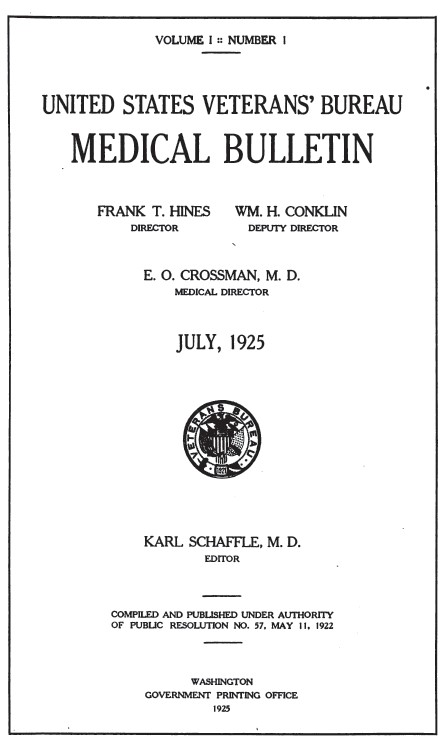
In the space of just a few years following World War I, the U.S. government created an expansive health system for ex-servicemembers under the direction of a new and independent federal agency, the Veterans’ Bureau. By 1924, the Veterans’ Bureau operated a nationwide network of forty-four hospitals and seventy-nine clinics that treated many thousands of Veterans suffering from tuberculosis, mental disorders, and other health conditions stemming from their wartime service. In March of that year, the bureau recruited twenty-two eminent physicians, specialists, and medical researchers to form a standing Medical Council to advise the agency on medical and administrative matters. One of the recommendations that emerged from the initial meeting of the council in July was that the bureau should publish a monthly medical journal featuring articles from the staff. Twelve months later, the first issue of the United States Veterans’ Bureau Medical Bulletin appeared in print.
The journal went hand-in-hand with one of the council’s other recommendations that the Veterans’ Bureau adopted: the launching of a hospital-based clinical research program. Dr. Edgar O. Crossman, the agency’s Medical Director, outlined his ambitions for the journal in his prefatory note to issue number one: “It is also expected to promote research along practical lines and to present the results of study of the wealth of medical statistics contained in the records of the bureau. It is evident that the field for investigation is unlimited and that the opportunity to make helpful application of the conclusions is unprecedented.” Doctors in the employ of the bureau were expected to submit at least one article per year to the journal. The bulletin also solicited contributions from staff in other positions, ranging from nurses and physical therapists to librarians and hospital managers.
The contents of the Medical Bulletin focused on the medical problems that were paramount among Veterans. Articles on tuberculosis led the way. Throughout the 1920s, Veterans diagnosed with the disease accounted for between twenty and forty percent of the patient population at Veterans’ Bureau hospitals. The 1926 issues of the bulletin devoted just under a quarter of its pages to this subject alone. The following year, the journal published ten major clinical research articles on the topic. Reports on the diagnosis and treatment of Veterans with psychiatric disorders also appeared frequently in the bulletin, particularly as mental illness replaced tuberculosis as the number one cause of hospitalization for former servicemembers. Other ailments that received coverage included syphilis, malaria, cancer, heart disease, and different types of combat trauma. While mainly concerned with clinical and therapeutic issues, the bulletin also served as a clearinghouse for news of professional interest to the agency’s medical staff. It reported on the initiatives of the Medical Council and happenings at Veterans hospitals, as well as on internal conferences and medical meetings hosted by outside organizations.

In 1930, after the Veterans’ Administration supplanted the Veterans’ Bureau, the Medical Bulletin changed the first part of its name to match that of its parent agency. During the Great Depression, budget pressures forced the journal to shift from a monthly to a quarterly publication schedule. Otherwise, the journal continued without pause until 1944, when it ceased publication altogether. Just two years later, however, the newly formed Department of Medicine and Surgery within VA resurrected the idea of a medical journal, albeit on a much more modest scale. In 1946, VA issued the first in a series of articles called Technical Bulletins. In contrast to the earlier journal, which often featured original research by bureau or VA clinicians, the Technical Bulletins were primarily educational in nature. The VA published the bulletins to help its doctors stay abreast of important developments in medicine and patient care.
During its 20-year print run, the Medical Bulletin served a valuable purpose within the Veterans’ Bureau and Veterans’ Administration by supporting the medical research program carried out by their clinical staffs. The journal provided bureau and VA physicians with a forum for presenting case studies, accounts of promising treatments, and other reports based on their extensive experience with patients in Veterans’ hospitals. The Medical Bulletin also fostered a sense of community among medical practitioners in the two agencies, facilitating the sharing of news and information across the health system.
By Katie Rories, Historian, Veterans Health Administration and Jeffrey Seiken, Ph.D., Historian, Veterans Benefits Administration
Share this story
Related Stories

History of VA in 100 Objects
Object 96: Postcard of Veterans Vocational School
In 1918, the government created the first nationwide vocational training system to help disabled Veterans acquire new occupational skills and find meaningful work. Over the next 10 years, more than 100,000 Veterans completed training programs in every field from agriculture and manufacturing to business and photography.

History of VA in 100 Objects
Object 95: 1840 Census of Pensioners
In a first, the 1840 census collected data on Veterans and widows receiving a pension from the federal government. The government published its findings in a stand-alone volume titled “A Census of Pensioners for Revolutionary or Military Services.”

History of VA in 100 Objects
Object 94: Southern Branch of the National Home
The Southern Branch of the National Home for Disabled Volunteer Soldiers opened in Hampton, Virginia, in late 1870. The circumstances surrounding the purchase of the property, however, prompted an investigation into the first president of the National Home’s Board of Managers, Benjamin Butler.


